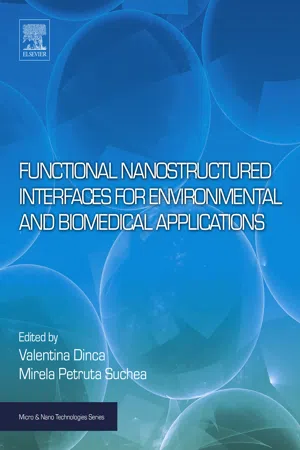

Functional Nanostructured Interfaces for Environmental and Biomedical Applications
- 411 pages
- English
- ePUB (mobile friendly)
- Available on iOS & Android
Functional Nanostructured Interfaces for Environmental and Biomedical Applications
About This Book
Functional Nanostructured Interfaces for Environmental and Biomedical Applications provides an overview on the characteristics of nanostructured interfaces and their processing technologies for a wide range of applications in the sensing, photocatalytic and bioengineering areas. The book focuses on the fundamentals of multifunctional nanostructured interfaces and their associated technologies, including versatile technologies, such as colloidal lithography, scanning probe techniques and laser nanostructuring, which can be used to obtain multifunctional 2D and 3D nanotextured interfaces. The book provides multidisciplinary chapters, summarizes the current status of the field, and covers important scientific and technological developments made over past decades.
As such, it is an invaluable reference to those working in the design of novel nanostructured materials.
- Covers emerging applications of nanostructured interfaces, with a focus on sensing, bio-related and environmental applications
- Provides detailed and up-to-date overviews on the characteristics of nanostructured interfaces and their processing technologies, including materials from multifunctional graphene, to extremophile materials
- Includes information about versatile technologies, such as colloidal lithography, scanning probe techniques and laser nanostructuring, all of which can all be used to obtain multifunctional 2D and 3D nanotextured interfaces
Frequently asked questions
Information
Multifunctional nanostructured interfaces: Origin and challenges for biomedical and environmental applications
† Center of Materials Technology and Photonics, School of Engineering, Technological Educational Institute of Crete, Heraklion, Greece
‡ Chemistry Faculty, University of Crete, Heraklion, Greece
§ National Institute for Lasers, Plasma and Radiation Physics, Magurele, Romania
Abstract
Keywords
1.1 Origin of interfaces
1.1.1 Definitions and terminology: Why nanostructuring?

1.1.2 Fundamentals of surface engineering and modification
1.1.3 Surface characterization methods
Table of contents
- Cover image
- Title page
- Table of Contents
- Copyright
- Contributors
- Chapter 1: Multifunctional nanostructured interfaces: Origin and challenges for biomedical and environmental applications
- Chapter 2: Chemical and physical methods for multifunctional nanostructured interface fabrication
- Chapter 3: Versatile micro- and nanotexturing techniques for antibacterial applications
- Chapter 4: Surface nanopatterning by colloidal lithography
- Chapter 5: Scanning probe techniques for nanoscale imaging and patterning
- Chapter 6: Laser processing of nanostructures: enhancing functional properties of lead-free perovskite nanostructures through chemical pressure and epitaxial strain
- Chapter 7: Extremophile-assisted nanomaterial production and nanomaterial-based biosensing
- Chapter 8: Biosensor technologies based on nanomaterials
- Chapter 9: Graphene-based materials and their biomedical and environmental applications: Recent advances
- Chapter 10: LDH-interlayered nanostructures for biomedical and environmental applications
- Chapter 11: Nanostructured ZnO-based materials for biomedical and environmental applications
- Chapter 12: Electrospun TiO2-based nanofiber composites and their bio-related and environmental applications
- Chapter 13: TiO2-based nanostructured materials with germicidal properties and other applications in biomedical fields
- Chapter 14: Applications of metallic nanostructures in biomedical field
- Chapter 15: Nanostructured tungsten oxide using pulsed laser deposition for biosensing and environmental sensing applications
- Index